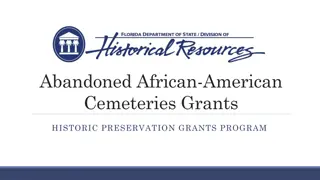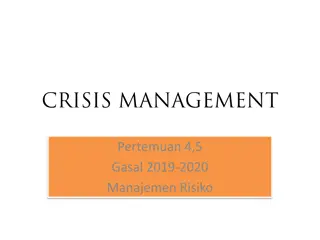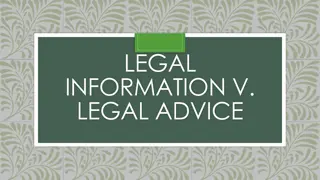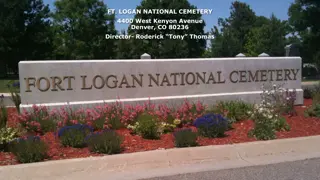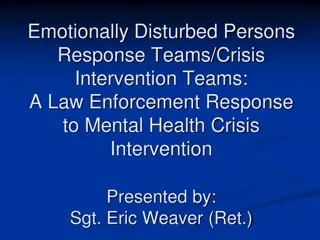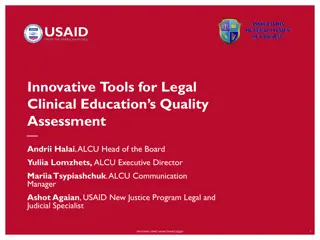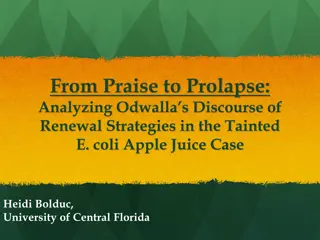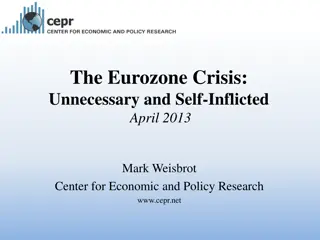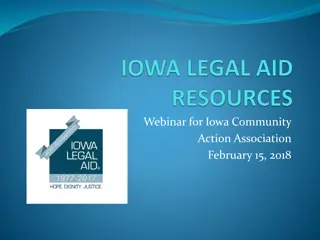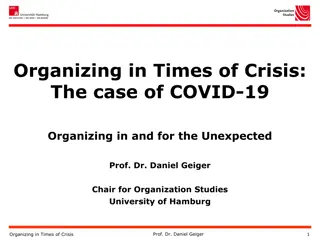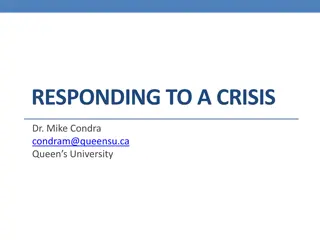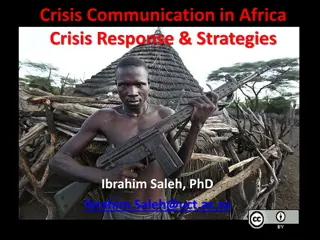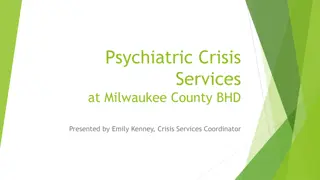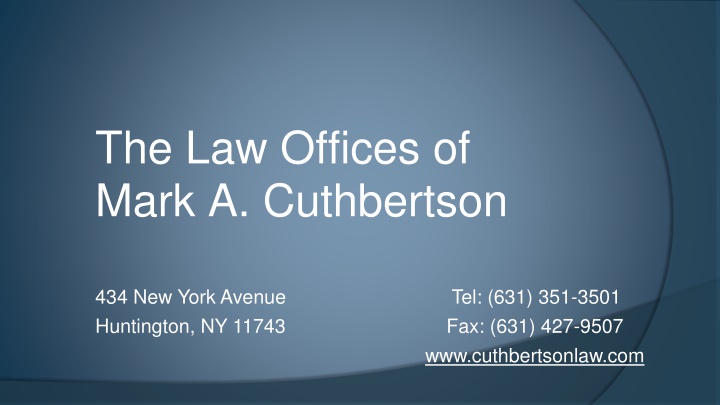
Legal Topics for Cemeteries: Crisis Response Guidelines
Experience and academic research provide clear guidelines on responding to crises effectively. Being quick, accurate, and consistent in communication is crucial for organizations dealing with crises.
Uploaded on | 1 Views
Download Presentation

Please find below an Image/Link to download the presentation.
The content on the website is provided AS IS for your information and personal use only. It may not be sold, licensed, or shared on other websites without obtaining consent from the author. If you encounter any issues during the download, it is possible that the publisher has removed the file from their server.
You are allowed to download the files provided on this website for personal or commercial use, subject to the condition that they are used lawfully. All files are the property of their respective owners.
The content on the website is provided AS IS for your information and personal use only. It may not be sold, licensed, or shared on other websites without obtaining consent from the author.
E N D
Presentation Transcript
The Law Offices of Mark A. Cuthbertson 434 New York Avenue Huntington, NY 11743 www.cuthbertsonlaw.com Tel: (631) 351-3501 Fax: (631) 427-9507
Selected Legal Topics For Cemeteries Metropolitan Cemetery Association 2016 Annual Meeting and Exposition
Selected Legal Topics For Cemeteries What Is Cemetery Law?
Selected Legal Topics For Cemeteries RESPONDING TO A CRISIS Experience and academic research have combined to create a clear set of guidelines for how to respond once a crisis hits. The initial crisis response guidelines focus on three points: (1) be quick, (2) be accurate, and (3) be consistent. 1. BE QUICK If the organization having the crisis does not speak to the news media, other people will be happy to talk to the media. These people may have inaccurate information or try to use the crisis as an opportunity to attack the organization. 2. BE ACCURATE Obviously accuracy is important any time an organization communicates with the public. However, inaccuracies make an organization look inconsistent. Incorrect statements must be corrected making an organization appear to be incompetent. 3. BE CONSISTENT Given the multiple possible means of possible communication, it is critical that an organization s message be consistent across all platforms.
Forming An Audit Committee For Your Cemetery Why Do People Become Accountants?
Forming An Audit Committee For Your Cemetery Since the passage of the Not-for-Profit Revitalization Act ("NPRA"), cemeteries have been required to designate an Audit Committee consisting entirely of "Independent Directors" or the Board of Directors (only independent board members may deliberate or vote with respect to audit committee functions) to oversee their accounting and financial reporting practices. Cemeteries with over one million dollars in revenues also have added responsibilities. While not required by NPRA, it is advisable to have at least one audit committee member with expertise in accounting and finance.
Forming An Audit Committee For Your Cemetery The Audit Committee must undertake the following responsibilities: (1) retain or renew a CPA to conduct the annual financial audit; (2) review the completed audit with the CPA; and (3) review communications with those charged with governance (including a management letter) that result from the audit.
Forming An Audit Committee For Your Cemetery For cemeteries with over $1 million in revenue, the Audit Committee must: (1) review the scope and planning of the audit prior to the audit; and (2) once the audit has been completed: (a) discuss with the CPA material risks and weaknesses in internal controls identified by the auditor, (b) assess any restrictions on the scope of the auditor's activity or access to requested information, (c) assess any significant disagreements between the auditor and management, and (d) assess the adequacy of accounting and financial reporting processes of the organization; and (3) annually review the performance and independence of the auditor.
Forming An Audit Committee For Your Cemetery Additional duties that an audit committee may undertake include: (a) Reviewing an organization's internal and financial controls assuring appropriate risk assessments and risk response plans; (b) Identifying and monitoring related party transactions; (c) Review of conflicts of interests, ethics and whistleblower policies; (d) Monitoring any legal matters that could impact the reputation and financial health of the cemetery; (e) Instituting and overseeing special investigatory work; and (f) Periodically reviewing the organization's insurance coverage.
Forming An Audit Committee For Your Cemetery A cemetery can adopt an Audit Committee Charter that outlines both the required responsibilities of the Audit Committee and the additional duties the Board of Directors can assign to the Audit Committee. The charter can serve as a road map for the Audit Committee's responsibilities. The Audit Committee is also designated as the body that reviews ethics and related party transactions, as well as allegations under the cemetery's whistleblower policy.
Forming An Audit Committee For Your Cemetery TAKEAWAY: The formation and functioning of an audit committee is not nearly as onerous as it seems, and cemeteries can easily implement these requirements with the help of their accounting and legal consultants.
Memorialization, Designations and Disinterment Memorialization 1512 (b)- Interest of deceased lot owner. Upon the death of an owner or co-owner of any plot or part thereof, the interest of the deceased lot owner shall pass to: (a) the devises (those granted property in a will) of such lot owner, but, if such interest be not effectually devised, then to (b) his or her descendants (children, grandchildren, etc.) then surviving, and if there be none, (c) then to the surviving spouse, and if there be none, (d) then to those entitled to take the real and personal property of the deceased lot owner pursuant to article four of the estates, powers and trustlaw. However, no interest in any lot, plot or part thereof shall pass by any residuary or other general clause in a will. The surviving spouse of a deceased lot owner during his or her life and the owners from time to time of the deceased lot owner's lot, plot or part thereof, shall have in common the possession, care and control of such lot, plot or part thereof.
Memorialization, Designations and Disinterment Memorialization 1512 (c)- Purchase for burial of decedent. Whenever a plot or part thereof shall be purchased by the executor, administrator or representative of a decedent from estate funds for the burial of the decedent, the surviving spouse of the decedent shall have the right of interment therein. 1512 (d)- Right of interment. A deceased person shall have the right of interment in any lot, plot or part thereof of which he or she was the owner or co-owner at the time of his or her death, or in any tomb erected thereon. The surviving spouse shall have the right of interment for his or her body in a lot or tomb in which the deceased spouse was an owner or co-owner at the time of his or her death
Memorialization, Designations and Disinterment Memorialization 1512 (e)- More than one person entitled to possession and control. (1) At any time when more than one person is entitled to the possession, care and control of such lot, any of the persons so entitled thereto may file with the corporation an affidavit setting forth the names and places of residence of all the persons entitled to the possession, care and control of such lot, and the corporation shall be entitled to rely upon the truth of the statements contained in such affidavit. (2) At any time when more than one person is entitled to the possession, care or control of such lot, plot or part thereof, the persons so entitled thereto shall file with the corporation a designation of a person who shall represent the lot, plot or part thereof, and so long as they shall fail to designate, the corporation may make such designation.
Memorialization, Designations and Disinterment Memorialization The Original Purchaser Has Right to Memorialize As a general rule of law, the original purchaser or purchasers of a cemetery grave acquire the right to purchase the bronze marker for the grave and, if they wish to, decide upon the inscription to be used on the marker. Matter of Fentonville Cemetery Ass n, 238 App. Div. 491 (4th Dept. 1933). Matter of Rosen, 173 Misc. 433 (Sur.Kings 1940). If the original purchaser exercises the right to purchase the marker and decides upon the inscription for it, subsequent heirs or owners of the plot have no right to change the inscription. Fromer v. Schientag, 16 Misc.2d 953 (Sup. N.Y.1959). Right to Possession of the Body of the Decedent Includes Right to Memorialize Decedent In the absence of a testamentary direction or authorization pursuant to Cemetery Board Regulation 201.15 or a designation of a person as the one entitled to dispose of remains pursuant to 4201 of the Public Health Law, the right to possession of the body of decedent includes the right to memorialize belongs to the surviving spouse or next of kin.
Memorialization, Designations and Disinterment Memorialization The Surviving Spouse has a Superior Right to Memorialization than the Next of Kin. The surviving spouse has a superior right to determine the memorialization for the decedent spouse. Birch v. Birch, 123 Misc. 229 (Sup.West.1924), aff d 209 App. Div. 892 (2d Dept. 1924). If the surviving spouse fails to exercise the right to the possession of the body and/or the right to memorialize, then the next of kin acquires that right. Stiles v. Stiles, 113 Misc. 576 (Sup. N.Y.1920). Written Authorization Gives Right to Memorialize The Cemetery Board has issued a regulation for the situation where either the original purchaser or subsequent plot owners subscribe to a written authorization designating who may be buried in the grave, then such authorization includes the right-to-memorialize for the burial or burials so authorized. Cemetery Board Regulation 201.15. The person who has the right-to-memorialize in connection with such an authorization is the one having the right to possession of the body. Cemetery Board Regulation 201.15. Please remember this rule only applies to the situation arising under such an authorization.
Memorialization, Designations and Disinterment Memorialization Question: Deceased is the son of the plot owner. The wife of the deceased is the next of kin. The inscription order is mailed to the next of kin (wife), but the plot owner also wanted to order the bronze. Can the plot owner order?
Memorialization, Designations and Disinterment Memorialization Question: Deceased is the son of the plot owner. The wife of the deceased is the next of kin. The inscription order is mailed to the next of kin (wife), but the plot owner also wanted to order the bronze. Can the plot owner order? Answer: The plot owner has the superior right to memorialization of the plot.
Memorialization, Designations and Disinterment Memorialization Question: Deceased is the plot owner. One daughter is the next of kin. The other daughter is executor and therefore feels she should be in charge of any decisions regarding this plot. Who has the right to inscribe?
Memorialization, Designations and Disinterment Memorialization Question: Deceased is the plot owner. One daughter is the next of kin. The other daughter is executor and therefore feels she should be in charge of any decisions regarding this plot. Who has the right to inscribe? Answer: In the absence of a testamentary direction or one pursuant to Cemetery Board Regulation 201.15 or designation of a person as the one entitled to dispose of remains pursuant to 4201 of the Public Health Law, the two daughters would have an equal right to memorialize. The cemetery could request a designation from the two sisters of all people who were entitled to care custody and control of the plot and who should represent the plot and the absence of such a designation being produced could decide who to designate as the representative of the plot.
Memorialization, Designations and Disinterment Designations 1512 (f) At any time all the owners of a lot, and any surviving spouse having a right of interment therein, may execute, acknowledge and file with the corporation an instrument, and the sole owner of a lot may, in a testamentary instrument admitted to probate, make a provision, which may: (A) designate the person or persons or class of persons who may thereafter be interred in said lot or in a tomb in such lot and the places of their interment; (B) direct that upon the interment of certain named persons the lot or tomb in such lot shall be closed to further interments; (C) direct that the title of the lots shall upon the death of any one or more of the owners, descend in perpetuity to his, her, or their distributees, unaffected by any devise. 1512 (e)(2) At any time when more than one person is entitled to the possession, care or control of such lot, plot or part thereof, the persons so entitled thereto shall file with the corporation a designation of a person who shall represent the lot, plot or part thereof, and so long as they shall fail to designate, the corporation may make such designation.
Memorialization, Designations and Disinterment Disinterment Division of Cemeteries Guidance on Not-For-Profit Corporation Law 1510 (e)- Removals. Authorization to Disinter: During the course of operating a cemetery it is likely, if not inevitable, that a lot owner will request to have the body of a loved one disinterred. It is important that the cemetery understand their legal responsibilities when it comes to disinterment. Section 1510(e) of the N-PCL states that a body can be removed from a grave with the written consent of the owners of the lot, surviving spouse, children of the deceased, and parents of the deceased. In addition to these people, the cemetery corporation must consent. If any one of the above mentioned entities fails to give consent, then a court order must be obtained before the disinterment can take place. These authorizations are all that is required if the body is to be re- interred within the same cemetery.
Memorialization, Designations and Disinterment Disinterment Division of Cemeteries Guidance on Not-For-Profit Corporation Law 1510 (e)- Removals. If the body is to be moved to a different cemetery, the same authorizations must be received; however, the process must be handled by a licensed funeral director. The funeral director must obtain a permit from the registrar of vital statistics having jurisdiction at the place of disinterment. Family members will often ask to be present at the time of the disinterment; this is strongly discouraged. Suggest that they send a clergy person or a funeral director to witness the disinterment for them. If they still insist on being present, have them sign a release that clearly explains that the disinterment process is likely to be difficult to observe and the cemetery will be held harmless for any emotional distress caused by the viewing of the disinterment. Any time you have a question on disinterment procedures, contact your regional investigator or the Albany office of the Division for assistance. The full guidance can be found at: www.dos.ny.gov/cmty/bulletins/bulletin_109.html.
Memorialization, Designations and Disinterment Disinterment Courts have provided some general guiding principles in interpreting this statute: (1) If all consents are obtained, the applicant need not seek Court approval for the disinterment. (2) There is no common law cause of action for wrongful disinterment. (3) Generally, cemeteries will not be liable for emotional distress relating to disinterment unless there is malice or wantonness, such as mishandling or desecration of the decedent or casket. (4) An application for disinterment may be granted where the applicant shows good and substantial reasons. In determining whether such reasons exist, the Court will consider (a) the deceased s wishes expressed during his or her lifetime; (b) the religious convictions of the deceased; (c) by whose direction the choice of burial site was made; (d) the desires and motives of close family, especially a spouse in promoting a change of location; (e) the sanctity of sepulture.
Memorialization, Designations and Disinterment Disinterment If the deceased had been a member of a faith which forbade disinterment, if he or she had agreed with cemetery corporation that there would be no exhumation, if he or she had elected to be laid in hallowed earth, and if request was for reburial in unconsecrated ground, then only compelling considerations would justify disinterment and removal of his body. Currier v. Woodlawn Cemetery, 300 N.Y. 162, 90 N.E.2d 18 (1949). Damages Mittasch v. Seal Lock Burial Vault, Inc., 42 A.D.2d 573 (2d Dep t 1973) Burial vault warranty that cemetery would give satisfactory service at all times, which explicitly extended to future performance, was prospective warranty. Therefore, the Second Department held that the statute of limitations ran from the discovery of the breach, not the sale of the vault twelve years earlier. The cemetery, which did not sell the vault, was not part of the civil action.
New Overtime Rules Under Fair Labor Standards Act Overview On May 18, 2016, the U.S. Department of Labor published the Final Rule on Defining and Delimiting the Exemptions for Executive, Administrative, Professional, Outside Sales and Computer Employees under the Fair Labor Standards Act (FLSA) ( Final Rule ). This amends what is commonly known as the white-collar exemption to the FLSA s overtime rules. The FLSA requires that employees who work more than 40 hours per week be paid at 1.5x the normal hourly rate for each additional hour worked. However, certain employees may be exempt from this requirement if they meet three tests: (1) Minimum Salary Level, (2) Salary Basis, and (3) Standard Duties. An employee must meet all three tests to qualify for the exemption.
New Overtime Rules Under Fair Labor Standards Act The Minimum Salary Level Test The biggest change in the Final Rule is the increase to the minimum salary level. Previously, the threshold for the overtime exemption was $455 per week. Under the Final Rule, this threshold is more than doubled to $913 per week (or $47,476 per year). As a result, more than 4 million workers will now be eligible for overtime pay. In addition, non-discretionary bonuses, incentive payments, and commissions may now be counted as up to 10% of the minimum salary level. The Final Rule also includes an automatic update mechanism that adjusts the minimum salary level every three years. This first adjustment is scheduled for January 1, 2020. Initial estimates suggest it will raise the minimum salary level to $984 per week (or $51,168 per year). Finally, the threshold for the Highly Compensated Employee exemption, which allows a simplified duties test for workers above a certain minimum salary, will be raised from $100,000 to $134,004.
New Overtime Rules Under Fair Labor Standards Act The Standard Duties Test The proposed rulemaking suggested adopting California s quantitative approach to the duties test. However, this was ultimately omitted from the Final Rule. Accordingly, an employee s primary duty will continue to mean the main, principal or most important duty, and will be determined on a qualitative, rather than quantitative, basis. In addition, the specific duties for executive, administrative, and professional employees remain largely unchanged. Even though the DOL has not changed the duties test, this may be an opportune time for employers to evaluate positions to ensure they satisfy the duties test, which tends to be the most litigated issue in a challenge to an employee s classification. The Final Rule takes effect December 1, 2016, giving employers roughly half a year to adjust.
New Overtime Rules Under Fair Labor Standards Act What Does This Mean For Cemeteries? The wage and overtime provisions of the FLSA generally apply to employees of both non-profit and for-profit entities. Accordingly, many cemeteries may have employees covered under the new rule. Cemeteries may respond to this situation various ways, including some of the following ways: (1) Do Nothing: If your cemetery does not have any employees working more than 40 hours per week, or do not fall below the new minimum salary level, a change may be unnecessary. (2) Raise Salaries: If your cemetery has employees paid just below the new threshold, or regularly working overtime, it may be cost-effective to raise their salary above the new exemption threshold. Employers may also rework employment contracts so the weekly salary includes limited overtime. (3) Reorganize Workloads Or Hours: For some cemeteries, it may be possible to modify employee work schedules or move responsibilities between employees to avoid overtime situations. (4) Pay Overtime: Finally, cemeteries may simply pay overtime to newly qualifying employees
Recent Case Law Diocese of Rockville Centre v. Village Of Old Westbury
Diocese of Rockville Centre v. Village Of Old Westbury While it appears that this case will be settled, this case shows litigation under the Religious Land Use & Institutionalized Persons Act, 42 U.S.C. 2000cc, et seq. ("RLUIPA") can be a powerful weapon for a religious cemetery faced with an obstructionist municipality. While a municipality maintains the right to adopt reasonable zoning regulations under most circumstances, if it oversteps its bounds it can face significant damages and an award of attorney's fees. The Roman Catholic Diocese of Rockville Center has been in a protracted legal battle with the Village of Old Westbury for nearly 20 years over its proposed cemetery. After the Diocese successfully litigated that the proposed cemetery was a religious use, the Board of Trustees enacted a series of comprehensive zoning amendments, including a Places of Worship Law. After repeated delays in the approval process under the POW law, the Diocese filed suit alleging Constitutional and RLUIPA violations. The Board later approved the proposal, subject to restrictions including a requirement that approval was subject to renewal every five years, when the terms could be altered. Imagine if, once approved, a cemetery s existence was up for debate every five years.
Diocese of Rockville Centre v. Village Of Old Westbury The Court ruled on motions for summary judgment on September 3, 2015.The Court first found the POW Law was constitutional, in that it validly regulated building area, height, setbacks from property lines, screening, and traffic circulation to mitigate the "adverse impacts of large institutional facilities on the residential nature of the Village." In addition, the law did not treat the plaintiffs differently from other religious institutions. The Court next addressed the RLUIPA claims that the POW law (1) created a substantial burden on the property's religious use, and (2) treated the plaintiff on "less than equal terms than a nonreligious assembly or institution." On the first claim, the Diocese argued the conditions were arbitrary and unreasonable, particularly as the 5-year renewal provision undermined permanent burial. The Court found this claim viable, but held whether the law was narrowly tailored was a matter for trial, denying summary judgment. On the second claim, the Court noted that RLUIPA requires the government treat religious and non-religious institutions on "equal terms." However, the Second Circuit has held that applying different land use regimes to religious and non-religious institutions is not per se unequal treatment Thus the Court granted the defendants' motion for summary judgment, as the Diocese had failed to identify a comparable secular institution receiving more favorable treatment.
Diocese of Rockville Centre v. Village Of Old Westbury On May 23, 2016, the parties advised the Court that they have reached a settlement in principle, as to both the land use and money damages and attorneys fees aspects of the parties dispute.
Recent Case Law Lewis v. Lloyd Case centered on a dispute between decedent s mother and decedent s wife over control of the decedent s body. The Court discusses the standard for who controls remains and role of various documents in making that determination. Interestingly, the decedent s mother sought to prevent the wife from cremating decedent s body so that an autopsy may be conducted, on the theory that decedent s wife played a role in his death. The Court concluded: [t]he Legislature could not have intended for cemeteries, crematories, and funeral homes possessed of duly-authorized authorizations, death certificates, and related documentation to cross-examine grieving widows or widowers, children, parents, siblings or others to confirm the validity of the familial or personal status claimed under the Public Health Law, or to conduct independent investigations of such persons to protect themselves from potential liability. And so, the Second Department has broadly interpreted the statutory immunity for persons acting reasonably and in good faith in handling remains (see Public Health Law 4201(1)) so as to place the burden of proof on those who would dispute immunity. (See Mack v. Brown, 82 A.D.3d at 139-42).
Recent Case Law Oakwood Cemetery v. Village/Town of Mount Kisco Dispute over whether an amendment to the village zoning law that narrowed the definition of a cemetery to prevent the construction of crematorium was preempted by the Not-For-Profit Corporation Law. The Court found it was not. Gerardi v. Paul W. Harris Funeral Home Inc. Surviving spouse brings a claim for the common law right of sepulcher after funeral home gives remains to the executor of the estate. Decedent s will provided a desired place of burial, but did not designate a person responsible for the remains. Court discusses the immunity from civil liability under Public Health Law 4201, finding funeral home was not entitled to statutory immunity. Manson v. Manson Dispute between estranged parents regarding the proposed disinterment of their deceased son. The Court discusses the standard for allowing disinterment, i.e. whether there are good and substantial reasons to disturb the remains, and concludes petitioner has not met this burden.
The Law Offices of Mark A. Cuthbertson 434 New York Avenue Huntington, NY 11743 www.cuthbertsonlaw.com Tel: (631) 351-3501 Fax: (631) 427-9507

